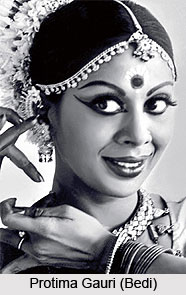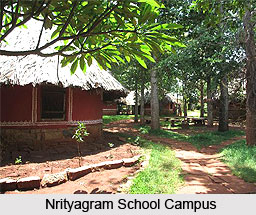 Nrityagram, an Indian dance academy is India`s first modern Gurukul (residential school), that was set up by Odissi danseuse Protima Gauri in 1990. This dance school is situated 35 km away from Bangalore. Nrityagram mainly trains students in Indian classical dance styles, namely Odissi, Mohiniattam, Kathak, Bharatnatyam, Kuchipudi, Kathakali and Manipuri.
Nrityagram, an Indian dance academy is India`s first modern Gurukul (residential school), that was set up by Odissi danseuse Protima Gauri in 1990. This dance school is situated 35 km away from Bangalore. Nrityagram mainly trains students in Indian classical dance styles, namely Odissi, Mohiniattam, Kathak, Bharatnatyam, Kuchipudi, Kathakali and Manipuri.
Nrityagram is a community of dancers in a remote place amidst nature. Protima Gauri visualised to set up Nrityagram in a place where nothing exists, except dance; a place where the students can breathe, eat, sleep, dream, talk, imagine only in forms of dance. She aimed at building Nrityagram as a place where dancers` negative qualities such as jealousy, small-mindedness, greed and malice will be eliminated and they will be able to embrace their colleagues as sisters and support each other in their path to success. Nrityagram has grown in its build by leaps and bounds and is known today for some of the best ensemble work in the arena of performing arts. The trademark of Nrityagram is perfection in dance along with a high level of good technical support, leading to an absolute presentation.
The current artistic director of Nrityagram is Surupa Sen. Bijayini Satpathy is in charge of the Odissi gurukul. Some of Nrityagram`s few but praiseworthy students include, Pavithra Reddy, who has had her solo debut in 2003 and who will be seen again in some solo pieces on a wider platform very soon. She has spent almost 12 years as an inhabited student at Nrityagram, and has learnt under the guidance of Surupa Sen and Bijayini Satpathy. Ayona Bhaduri and Priyambada Patnaik are also successful students at this gurukul. They both joined Nrityagram in 1998 and have been a part of the ensemble since 2001.
The striking feature of Nrityagram is its age-old Gurukul tradition. As per this ancient method, students look after and take care for their Guru by growing fruit and vegetables on the land, cleaning, cooking, and earning through dance recitals. At Nrityagram, the institution fulfills the role of the Guru as the protector and bestower of knowledge and experience. Trainees learn under the expert guidance of several Gurus. However their duties towards Nrityagram are of great importance. Besides, intensive dance training, they also learn about Indian Literature, history of dance, Sanskrit, mythology, poetry, music, philosophy, aesthetics, spirituality and dance theories.

Regular workshops are organised in martial arts, mime, yoga, meditation, sculpture and so on. These workshops help the students to use the body, help to improve stances and energy levels. They also instill an awareness of the interdisciplinary approach and a perceptive of the inter-relatedness of all arts and physical traditions, not only of India, but also of foreign countries. At Nrityagram, the students are made to learn the motto that dance is a way of life, a matter of faith and belief, cultivated and enriched by the soul of its own people. They believe that being a good dancer is second only to being a good human being.
Nrityagyan has promoted a programme of `Dance Education` as part of its policy of popularising the Indian classical arts. Nrityagyan has been successfully imparting dance education to young people, adhering with the philosophies of preserving Indian classical dance by imparting training without restrictions of finance. The faculties also conduct sensitisation and knowledge building programmes for lay people so that the audience base for the classical arts will be extended. Nrityagram has opened a world of classical dance to students through lecture demonstrations in schools, universities, community associations and others so that young people will learn about Indian Classical Dance.
The Nrityagram Dance Ensemble is not just a dance company. It is a crucible of motivation and ideas, a coming together of imaginative minds, which thrust themselves to the supreme limits of their abilities. A space where the dancers, musicians and choreographers live together for years, thus developing their ideas, perfecting their style and technique and complementing their learning of dance with a knowledge of mythology and the epics like Sanskrit, yoga, meditation and the martial arts.
With exceptional popularity, the Nrityagram has earned national and international acclaim for its ability to redefine both dance and theatre and to create and communicate with powerful imagery and captivating dance styles.



















